“One of the most memorable was born of his creative interpretation of a performing sea lion that caught his eye at the zoo.”





“One of the most memorable was born of his creative interpretation of a performing sea lion that caught his eye at the zoo.”


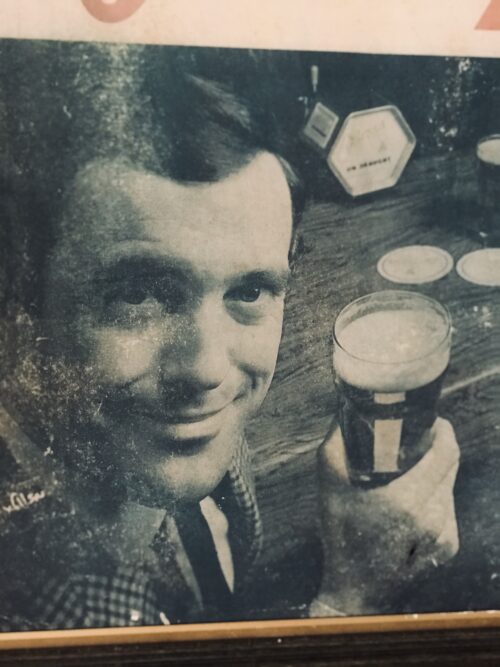
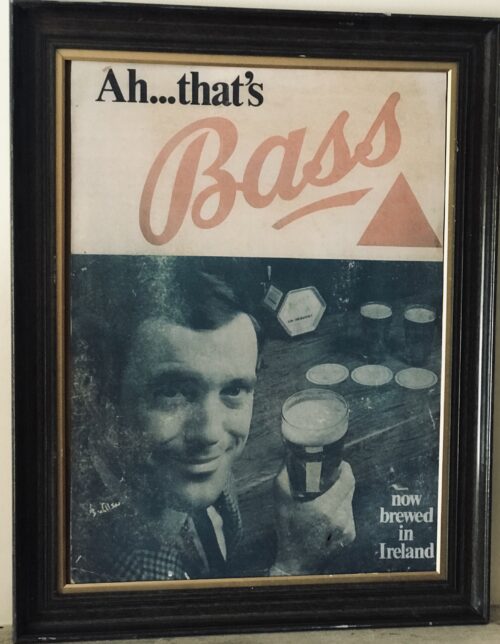
The former beer of choice of An Taoiseach Bertie Ahern,the Bass Ireland Brewery operated on the Glen Road in West Belfast for 107 years until its closure in 2004.But despite its popularity, this ale would be the cause of bitter controversy in the 1930s as you can learn below.
Founded in 1777 by William Bass in Burton-upon-Trent, Staffordshire, England.The main brand was Bass Pale Ale, once the highest-selling beer in the UK.By 1877, Bass had become the largest brewery in the world, with an annual output of one million barrels.Its pale ale was exported throughout the British Empire, and the company's distinctive red triangle became the UK's first registered trade mark. In the early 1930s republicans in Dublin and elsewhere waged a campaign of intimidation against publicans who sold Bass ale, which involved violent tactics and grabbed headlines at home and further afield. This campaign occurred within a broader movement calling for the boycott of British goods in Ireland, spearheaded by the IRA. Bass was not alone a British product, but republicans took issue with Colonel John Gretton, who was chairman of the company and a Conservative politician in his day.In Britain,Ireland and the Second World War, Ian Woods notes that the republican newspaper An Phoblacht set the republican boycott of Bass in a broader context , noting that there should be “No British ales. No British sweets or chocolate. Shoulder to shoulder for a nationwide boycott of British goods. Fling back the challenge of the robber empire.”
In late 1932, Irish newspapers began to report on a sustained campaign against Bass ale, which was not strictly confined to Dublin. On December 5th 1932, The Irish Times asked:
Will there be free beer in the Irish Free State at the end of this week? The question is prompted by the orders that are said to have been given to publicans in Dublin towards the end of last week not to sell Bass after a specified date.
The paper went on to claim that men visited Dublin pubs and told publicans “to remove display cards advertising Bass, to dispose of their stock within a week, and not to order any more of this ale, explaining that their instructions were given in furtherance of the campaign to boycott British goods.” The paper proclaimed a ‘War on English Beer’ in its headline. The same routine, of men visiting and threatening public houses, was reported to have happened in Cork.
It was later reported that on November 25th young men had broken into the stores owned by Bass at Moore Lane and attempted to do damage to Bass property. When put before the courts, it was reported that the republicans claimed that “Colonel Gretton, the chairman of the company, was a bitter enemy of the Irish people” and that he “availed himself of every opportunity to vent his hate, and was an ardent supporter of the campaign of murder and pillage pursued by the Black and Tans.” Remarkably, there were cheers in court as the men were found not guilty, and it was noted that they had no intention of stealing from Bass, and the damage done to the premises amounted to less than £5.
A campaign of intimidation carried into January 1933, when pubs who were not following the boycott had their signs tarred, and several glass signs advertising the ale were smashed across the city. ‘BOYCOTT BRITISH GOODS’ was painted across several Bass advertisements in the city.
Throughout 1933, there were numerous examples of republicans entering pubs and smashing the supply of Bass bottles behind the counter. This activity was not confined to Dublin,as this report from late August shows. It was noted that the men publicly stated that they belonged to the IRA.
September appears to have been a particularly active period in the boycott, with Brian Hanley identifying Dublin, Tralee, Naas, Drogheda and Waterford among the places were publicans were targetted in his study The IRA: 1926-1936. One of the most interesting incidents occurring in Dun Laoghaire. There, newspapers reported that on September 4th 1933 “more than fifty young men marched through the streets” before raiding the premises of Michael Moynihan, a local publican. Bottles of Bass were flung onto the roadway and advertisements destroyed. Five young men were apprehended for their role in the disturbances, and a series of court cases nationwide would insure that the Bass boycott was one of the big stories of September 1933.
The young men arrested in Dun Laoghaire refused to give their name or any information to the police, and on September 8th events at the Dublin District Court led to police baton charging crowds. The Irish Times reported that about fifty supporters of the young men gathered outside the court with placards such as ‘Irish Goods for Irish People’, and inside the court a cry of ‘Up The Republic!’ led to the judge slamming the young men, who told him they did not recognise his court. The night before had seen some anti-Bass activity in the city, with the smashing of Bass signs at Burgh Quay. This came after attacks on pubs at Lincoln Place and Chancery Street. It wasn’t long before Mountjoy and other prisons began to home some of those involved in the Boycott Bass campaign, which the state was by now eager to suppress.

An undated image of a demonstration to boycott British goods. Credit: http://irishmemory.blogspot.ie/
This dramatic court appearance was followed by similar scenes in Kilmainham, where twelve men were brought before the courts for a raid on the Dead Man’s Pub, near to Palmerstown in West Dublin. Almost all in their 20s, these men mostly gave addresses in Clondalkin. Their court case was interesting as charges of kidnapping were put forward, as Michael Murray claimed the men had driven him to the Featherbed mountain. By this stage, other Bass prisoners had begun a hungerstrike, and while a lack of evidence allowed the men to go free, heavy fines were handed out to an individual who the judge was certain had been involved.
The decision to go on hungerstrike brought considerable attention on prisoners in Mountjoy, and Maud Gonne MacBride spoke to the media on their behalf, telling the Irish Press on September 18th that political treatment was sought by the men. This strike had begun over a week previously on the 10th, and by the 18th it was understood that nine young men were involved. Yet by late September, it was evident the campaign was slowing down, particularly in Dublin.
The controversy around the boycott Bass campaign featured in Dáil debates on several occasions. In late September Eamonn O’Neill T.D noted that he believed such attacks were being allowed to be carried out “with a certain sort of connivance from the Government opposite”, saying:
I suppose the Minister is aware that this campaign against Bass, the destruction of full bottles of Bass, the destruction of Bass signs and the disfigurement of premises which Messrs. Bass hold has been proclaimed by certain bodies to be a national campaign in furtherance of the “Boycott British Goods” policy. I put it to the Minister that the compensation charges in respect of such claims should be made a national charge as it is proclaimed to be a national campaign and should not be placed on the overburdened taxpayers in the towns in which these terrible outrages are allowed to take place with a certain sort of connivance from the Government opposite.
Another contribution in the Dáil worth quoting came from Daniel Morrissey T.D, perhaps a Smithwicks man, who felt it necessary to say that we were producing “an ale that can compare favourably with any ale produced elsewhere” while condemning the actions of those targeting publicans:
I want to say that so far as I am concerned I have no brief good, bad, or indifferent, for Bass’s ale. We are producing in this country at the moment—and I am stating this quite frankly as one who has a little experience of it—an ale that can compare favourably with any ale produced elsewhere. But let us be quite clear that if we are going to have tariffs or embargoes, no tariffs or embargoes can be issued or given effect to in this country by any person, any group of persons, or any organisation other than the Government elected by the people of the country.
Tim Pat Coogan claims in his history of the IRA that this boycott brought the republican movement into conflict with the Army Comrades Association, later popularly known as the ‘Blueshirts’. He claims that following attacks in Dublin in December 1932, “the Dublin vitners appealed to the ACA for protection and shipments of Bass were guarded by bodyguards of ACA without further incident.” Yet it is undeniable there were many incidents of intimidation against suppliers and deliverers of the product into 1933.
Not all republicans believed the ‘Boycott Bass’ campaign had been worthwhile. Patrick Byrne, who would later become secretary within the Republican Congress group, later wrote that this was a time when there were seemingly bigger issues, like mass unemployment and labour disputes in Belfast, yet:
In this situation, while the revolution was being served up on a plate in Belfast, what was the IRA leadership doing? Organising a ‘Boycott Bass’ Campaign. Because of some disparaging remarks the Bass boss, Colonel Gretton, was reported to have made about the Irish, some IRA leaders took umbrage and sent units out onto the streets of Dublin and elsewhere to raid pubs, terrify the customers, and destroy perfectly good stocks of bottled Bass, an activity in which I regret to say I was engaged.
Historian Brian Hanley has noted by late 1933 “there was little effort to boycott anything except Bass and the desperation of the IRA in hoping violence would revive the campaign was in fact an admission of its failure. At the 1934 convention the campaign was quietly abandoned.”
Interestingly, this wasn’t the last time republicans would threaten Bass. In 1986 The Irish Times reported that Bass and Guinness were both threatened on the basis that they were supplying to British Army bases and RUC stations, on the basis of providing a service to security forces.
Origins : Co Limerick
Dimensions:35 cm x 45cm


John Gilroy, illustrator of some of Guinness’s most well-known advertisements.

With John Gilroy’s illustrations and Dorothy Sayers’s copy, the Guinness toucan ads were an immediate hit. (Guinness)

Guinness coasters featuring the menagerie of John Gilroy’s advertisements. (Guinness)
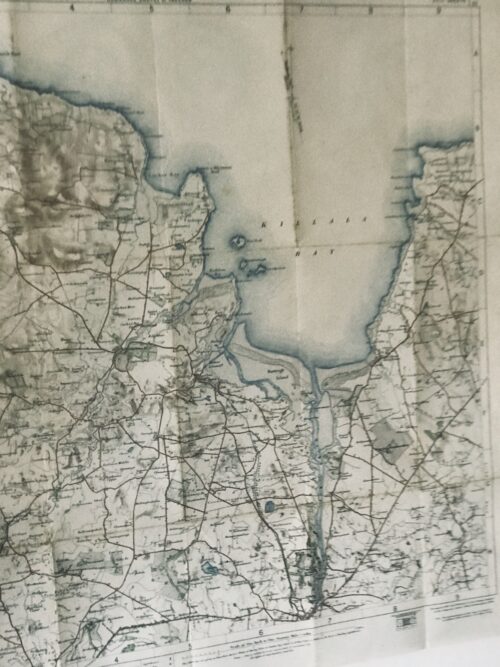

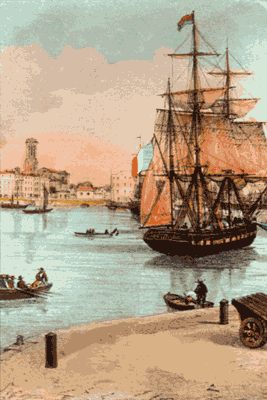
La Rochelle’s harbour.
On July 19, 1798, the French Directory authorises the sending of three expeditions to Ireland and gives command of the first one to General Humbert.
On August 6, 1798, General Humbert’s Army of Ireland sailed from La Rochelle in three frigates La Concorde, La Franchise, La Médée, carrying 1,025 French troops, 3 light field cannons, 3,000 muskets, and 400 sabres.
There were also a number of Irish among Humbert’s command. These included Bartholomew Teeling and Fr. Henry O Kane. This tiny force, together with its Irish allies, was to conduct an extraordinary campaign that shook the British Empire.During 16 days they sailed taking a circuitous route to avoid detection by the British navy. The mission of this little French expeditionary force was to provide military assistance to the Irish rebels of the “Rising of ’98” – sometimes referred to as “Bliadhan na bhFrancach” or “The Year of the French” – in their attempt to free Ireland from English domination.
The fleet had originally planned to land in Co. Donegal, but due to storm and no doubt influenced by the presence of Fr. O Kane who was a native of Killala the fleet sailed into Killala Bay.
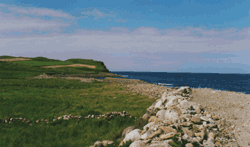
Kilcumminn head, Co. Mayo
On the 22nd of August, 1798, the three frigates landed at Kilcummin flying the English colours.
Edwin and Arthur Stock, sons of the Protestant Bishop of Killala, who had sailed out to meet them, greeted them. The two were captured, the English flag taken down and the French flag hoisted.
One of the first to disembark was Fr. O Kane who spoke to the locals in Irish which was the native tongue of most of the Irish at that time. Word soon filtered to native Irish throughout Mayo and Sligo.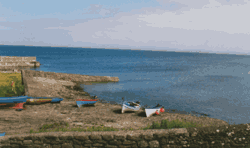
Kilcumminn strand,landing-place of the French
Bishop Stock also heard of the arrival and he sent messages to the local gentry among them the Jacksons, the Knoxs, Binghams, Palmers and Kirkwoods. Into the relative quiescence of northwest Ireland, the French expeditionary force fell like a thunderbolt. By about 7pm the landing was complete.
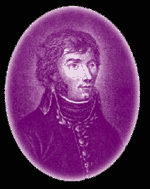
General Humbert
Young Général Jean-Joseph-Amable Humbert (the landing occurred on his 31st birthday), a canny veteran of irregular warfare against the insurgents of the Vendée, was well aware of the odds against him in a conventional military showdown, but also of the multiplying effects of surprise and speed.
He was also keenly aware of the importance of early victory for exciting the morale of the Irish insurgents and dismaying the ill-trained loyalist militia.
The first military confrontation occurred on the afternoon of 22 August, when Colonel Jean Sarrazin led a group of French Grenadiers south to the nearby village of Killala.

Killala, viewed from the north.
The garrison of 200 men included a handful of regulars of the 17th Foot (Leicestershire Regiment), but was mostly composed of the Yeomanry, an ill-trained part-time paramilitary constabulary.
With a portion of Sarrazin’s force circling around the British left flank and the remainder pressing a frontal attack with the bayonet, the unnerved Loyalists fired one ragged volley and then fled in terror towards Ballina.
Three Frenchmen were slightly wounded, bishop Stock’s palace was taken over as Humbert’s H.Q. and several of the yeomen were taken prisoner.

Ireland forever – l’Irlande pour toujours
A French soldier then climbed to the top of the palace and removed the British flag, which was replaced by a green and gold flag bearing the inscription ‘Erin Go Bragh’ (Ireland forever).
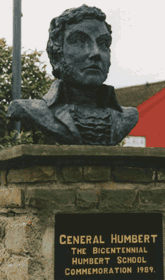
General Humbert statue in Killala.
LIBERTY, EQUALITY, FRATERNITY, UNION “After several unsuccessful attempts behold at last Frenchmen arrived amongst you . . . “Brave Irishmen, our cause is common. Like you we hold as indefeasible the right of all nations to liberty. Like you we are persuaded that the peace of the world shall ever be troubled as long as the British ministry is suffered to make with impunity a traffic of the industry and blood of the people . . . “Union, Liberty, the Irish Republic! Such is our shout. Let us march. Our hearts are devoted to you; our glory is in your happiness.”
From General Humbert’s Proclamation of 22nd August, 1798. (This last sentence of Humbert’s Proclamation became our pub’s motto!)
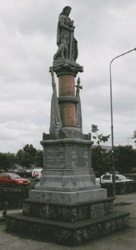
Mémorial de Ballina
This initial humbling of their oppressors had the desired effect on the local population, bringing forward thousands of eager, though ignorant and ill-disciplined Irish volunteers who were hastily equipped and formed into companies. Muskets were issued to some, but as in the uprisings elsewhere in Ireland that year, most of the insurgents were armed with crude pikes, scythes, and hay-forks.
On the 24th of August, having captured Killala, Humbert sent two groups under Sarrazin (provisionally promoted to Général de Brigade by Humbert on 23 August) and Adjudant-General Fontaine to capture Ballina.That night a fight took place between Sarrazin’s troops and the British at Rosserk. The English eventually retreated in confusion. The next morning the French/Irish troops captured Ballina under cover of darkness. The Irish peasants lit bundles of straw to show them their way. This approach road to Ballina has since been known as Bothair na Sop. They took Ballina without much resistance. The English for the most part fled towards Foxford where they would have their forces waiting for the French advance on Castlebar.
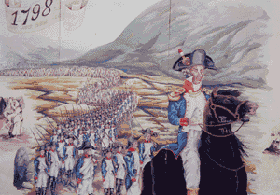
Humbert – Windy Gap Pass
The British commander in County Mayo, General Hutchinson, expected Humbert to continue south along the only decent road out of Ballina toward Castlebar, the commercial and strategic center of the region.
Where the road crosses the River Moy at Foxford, Hutchinson placed a strong blocking force with ample artillery. Clashes of French and British patrols along the Ballina-Foxford road appeared to confirm British expectations.Humbert, closely questioning the locals, learned that there was an alternative route to Castlebar, a barely-practicable goat-trail that ran west of Lough Conn, over the Windy Gap pass, and then south to the town. He resolved to take this route.
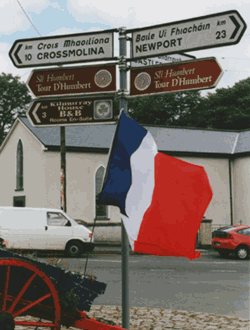
“Tour D’Humbert” signposts in Lahardane
The local priest, Father Andrew Conroy, was fluent in French from his time at seminary in Nantes.
He gave precious directions to the French officers and marshalled the people to provide food and assistance to the troops. In the aftermath of the campaign, Father Conroy was arrested, tried, and executed by the vengeful British.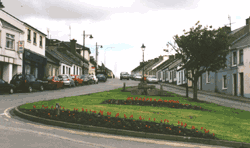
Sion Hill (now built-up)
A yeoman farmer who had been tending to his cattle had spotted the French/Irish advance party. He immediately fled to Castlebar to warn the British commander of the eminent arrival of the French/Irish forces.
The English forces took up position at Sion Hill just outside the town. Humbert approached and took account of the English position.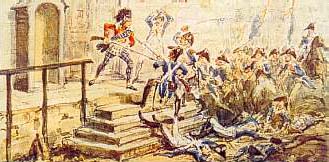
Batlle of Castlebar known as “Races of Castlebar”.
Following a number of attacks in which they were hit by British cannon, Humbert decided to regroup and divided his troops, splitting them to the left and right so as to attack the English flanks. The Irish drove a herd of cattle ahead of them causing confusion in the English rank. The French/Irish made an effective bayonet charge through the centre.
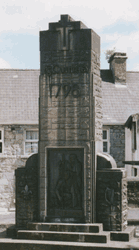
Castlebar Memorial
The English retreated down Staball Hill. Another attack occurred at Main St. Bridge. The English defended the bridge for some time using forces from the Longford and Kilkenny militias and Fraser Fencibles (a Scottish regiment).
There was confused fighting in the town as knots of the more stalwart British, notably the Fraser Fencibles and Roden’s Dragoons, attempted to make a stand.
The bulk of the redcoat forces, abandoning all guns, standards, and baggage, ran in headlong flight down the road to Tuam, 54 km (34 miles) to the southeast; some apparently did not stop until reaching Athlone, a further 68 km (42 miles) away. General Lake’s army being dissolved.
The event has since become mockingly known among the Irish as “The Castlebar Races.” In all the attack only lasted six hours from 6a.m. to 12 noon and has been described by Thomas Pakenham in The Year of Liberty as one of the most ignominious defeats in British military history. Following this brilliant victory, Humbert spent the next few days resting and reorganizing his army, absorbing many hundreds of new Irish volunteers including some 250 deserters from the Longford and Kilkenny Militias.Army of Ireland – Liberty, Equality
Head quarters at Castlebar, 14th Fructidor, sixth Year of the French Republic, One and Indivisible. General Humbert, Commander in Chief of the Army of Ireland, desirous of organizing with the least possible delay, an administrative power for the Province of Connaught, decrees as follows:
1. The Government of the Province of Connaught shall reside at Castlebar till further orders. 2. The Government shall be composed of twelve members, who shall be named by the General-in-chief of the French Army. 3. Citizen JOHN MOORE is named President of the Government of the Province of Connaught, he is specially entrusted with the nomination and reunion of the members of the Government. 4. The Government shall occupy itself immediately in organizing the Military power of the Province of Connaught, and with providing subsistence for the French and Irish Armies. 5. There shall be organized eight regiments of infantry, each of twelve hundred men, and four regiments of cavalry, each of six hundred men. 6. The Government shall declare rebels and traitors to the country all those who having received clothing and arms, shall not join the army within four and twenty hours. 7. Every individual from sixteen years of age to forty, inclusive, is REQUIRED in the name of the Irish Republic, to betake himself instantly to the French Camp, to march in a mass against the common enemy. The General Commanding-in-Chief HUMBERT.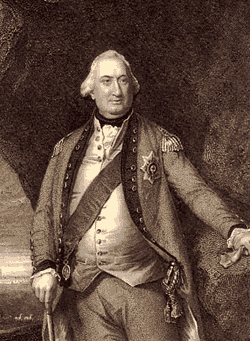
Lord Cornwallis
By the 2nd of September, Cornwallis had 7,800 men, including two reliable Scottish regiments (the Sutherland and Rehy Fencibles) concentrated at Tuam, organized into four brigades under Generals Hunter, Campbell, Hutchinson, and Moore (later the hero of Corunna), and a further 2,800 at Boyle.
Cornwallis advanced from Tuam on the 4th of September, but on arriving at Castlebar on the 5th found only a small Franco-Irish rearguard. Aware of the impossibility of defeating the well-equipped and far more numerous Crown forces, and with no sign of reinforcements from France, Humbert had marched off to the east on 4 September, under cover of darkness, taking his army, now totalling 3,000 men, towards Sligo, covering 58 miles in 36 hours. The long march had begun. Some Irish troops under French officers remained to protect Killala and receive the expected reinforcements.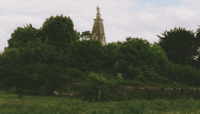
Collooney, Co. Sligo
On the morning of the 5th of September, an English army from Sligo under Col Vereker attacks the Franco-Irish army at Collooney with its left protected by the Ballysadare River and its right anchored on a steep, wooded hill. Humbert again outmanoeuvres them.
In what may be one of the greatest feats of individual bravery in the long history of the Revolutionary and Napoleonic Wars, Colonel Bartholomew Teeling, a United Irishman holding a French commission, galloped forward alone to the British line, pistolled the enemy gunner at point-blank range, and rode back unscathed under a hail of musket-fire. Inspired by his example, the Irish and French surged forward and routed the Loyalists. The English retreated with heavy losses as far as Ballyshannon, County Donegal.
Ballinamuck pikeman
On September 7, shortly before noon Humbert’s army crosses the Shannon at Ballintra Bridge just south of Loch Allen, but they fail in an attempt to demolish the bridge behind them.
His army shows signs of fatigue and skirmishes with the English advance guard become more frequent. The race for Granard quickens.
The Franco-Irish army reaches Cloone, in South Leitrim, while Cornwallis, with 15,000 men is at Mohill, five miles away. Humbert gets news that he is surrounded and outnumbered but decides to push on even if the best he can now do is to make a token resistance before surrender.On September 8, 1798, near the small village of Ballinamuck, County Longford, Humbert drew up his 859 French troops in line of battle. There could be little doubt of the outcome.
Behind Humbert was Cornwallis blocking Humbert’s way to Dublin. In front was Lake’s 6000 men. The battle which lasted but half an hour commenced with Colonel Crawford’s dragoons cutting through the Irish rebels. When the British grand assault poured up the hill from three sides, in overwhelming numbers, Humbert gave the order to surrender.
Humbert surrenders in Ballinamuck
The French officers followed their general’s signal and ordered their men to lay down their muskets. A second body of British cavalry had reined in seeing the signs of surrender, but Colonel Teeling, an Irish officer in the French army, had not signaled surrender so British infantry advanced on them. Crawford attacked a large contingent of Irishmen with his dragoons, their sabres sparing only those with officers insignia, hanging to be their fate.
Later testimonies reveal that on arresting Humbert, General Lake could not conceal his astonishment: “Where is your army?” Lake demanded “This is it all” Humbert replied, indicating his soldiers. “And what were you planning to do with this lot?” Lake asked. “We were going to Dublin to break the irons of a nation that suffers under your yoke” Humbert said. “That is an idea that could only be born in a Frenchman’s brains!” Lake declared.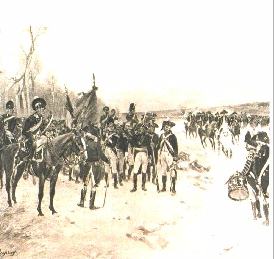
Humbert surrenders in Ballinamuck
Humbert and the French prisoners were conducted to Dublin and treated with all the consideration that could be given to gallant prisoners after an honorable defeat.
Not so the Irish. Accounts vary, but it appears that many of the Irish were cut down where they stood, or driven into the bog south of the hill where they were hunted down and slaughtered. Captured Irish officers, even those bearing legitimate commissions in the French army, were seized and hanged as traitors. Such was Bartholomew Teeling, Matthew Tone and Gunner James Magee’s fate.“After having obtained the greatest successes and made the arms of the French Republic triumph during my stay in Ireland, I have at length been obliged to submit to a superior force of 30,000 troops.” General Humbert’s Report to the French Directory after Ballinamuck.
‘A SHORT BUT VERY FATIGUING CAMPAIGN’
English historians have always treated General Humbert’s expedition to Ireland with ridicule, but Brian O hUiginn was fond of quoting Plowden the military correspondent of the London Times who held a different view. This expert wrote some years ago:
“In these operations described by Cornwallis to the Duke of Portland as a short but very fatiguing campaign, a raiding party of 1000 French landed in Ireland without opposition, after sixteen days of navigation, unobserved by the British Navy; defeated and drove back the British troops opposing them on four separate occasions; routed a force of second line troops of at least double its strength; captured eleven British guns; held the field for seventeen days; entirely occupied the attention of all the available troops of a garrison of Ireland 150,000 strong; penetrated almost to the centre of the island, and compelled the Lord Lieutenant to send an urgent requisition to London for ‘as great a reinforcement as possible.’ “
This was a fine tribute to General Humbert and his troops.The Charentais of the expedition.
Many Charentais took part in the expedition. Among them: Daniel Savary, who was born in Salles sur Mer (17), was in command of the naval division charged with transporting the expedition from La Rochelle to Killala. François Babin, born in Péré (17), became Commander of the Castlebar battalion. Jean Jobit, born in Chateauneuf en Charente (16), was a Commander on the Castlebar battlefield in Castlebar. Jean-Paul Leugerat, born in Barbezières (16), died during the battle of Castlebar.














John Connolly and Fr Martin Downey, with a photo of Fr Griffin, courtesy of Ciaran Tierney Digital Storyteller.



|
||||




The Dublin-born painter Richard Moynan was 24 years old at the commencement of his artistic training. He was educated with a view to entering the medical profession and proceeded so far on the course to need only his final examination to qualify, but his artistic instincts proved to be too strong to be resisted, and he abandoned the profession of medicine for that of art, and made it his life long study. (The Irish Times, 11 April 1906, p. 5.) Moynan entered the Dublin Metropolitan School of Art (DMSA) in January 1880, having initially studied there on a part-time basis. Due to an Act of Parliament passed in 1877 the school came under the control of the Department of Science and Art of South Kensington, which aligned it with the British art education system. The headmaster, Robert Edwin Lyne, was a product of this education as he had received his instruction in the (British) National Training School prior to taking up his appointment in Dublin in 1863. In the DMSA, Moynan gained the requisite qualifications in 'Freehand, Geometry, Perspective and Object Drawing, 2nd grade' (Thoms, 1891, p. 833), which allowed him entry to the Royal Hibernian Academy Schools in 1882. The following July he was awarded the 'Albert Scholarship for the best picture shown in the Academy by a student' (Strickland, Vol II, 1913, p. 144). This enabled the artist to continue his studies in Académie Royale des Beaux Arts in Antwerp, moving on to Paris in 1885, where he honed his skills in portraiture at Académie Julian. Moynan returned to his native Dublin in December 1886 to establish a practice as a portrait painter, but he also pursued his craft in terms of genre scenes, history painting and literary subjects. The painting, Military Manoeuvres (1891), marks a watershed in the artist's development. It demonstrates his art-making process and provides an insight into his political beliefs.








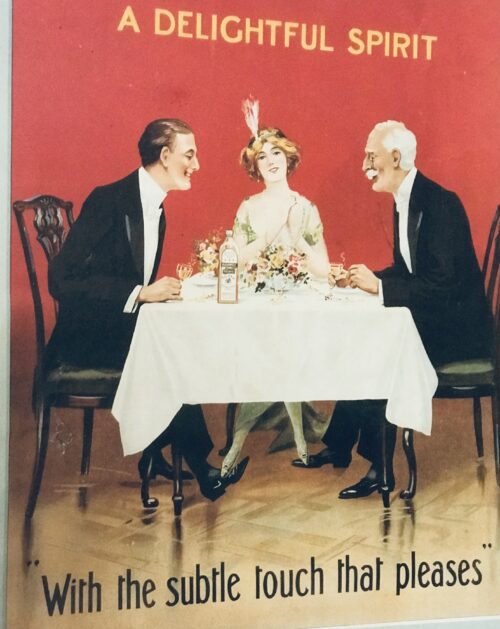
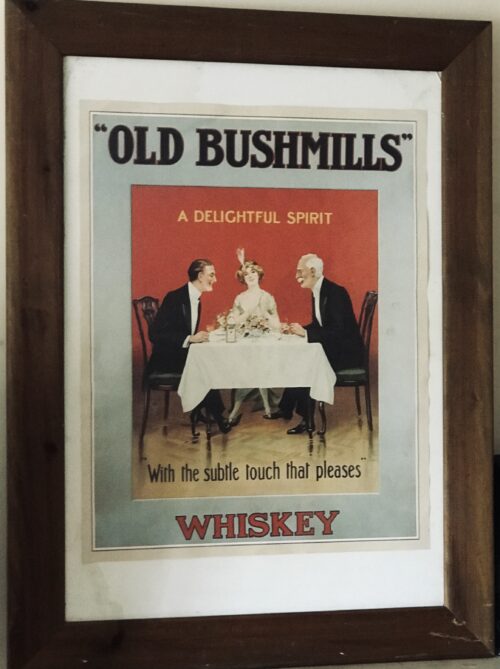
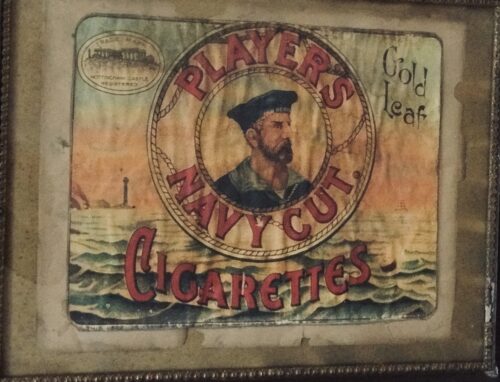




| Date | Performer(s) | Opening act(s) | Tour/Event | Attendance | Notes |
|---|---|---|---|---|---|
| 29 June 1985 | U2 | In Tua Nua, R.E.M., The Alarm, Squeeze | The Unforgettable Fire Tour | 57,000 | First Irish act to have a headline concert. Part of the concert was filmed for the group's documentary Wide Awake in Dublin. |
| 28 June 1986 | Simple Minds | Once Upon A Time Tour | Guest appearance by Bono | ||
| 27 June 1987 | U2 | Light A Big Fire, The Dubliners, The Pogues, Lou Reed | The Joshua Tree Tour | 114,000 | |
| 28 June 1987 | Christy Moore, The Pretenders, Lou Reed, Hothouse Flowers | ||||
| 28 June 1996 | Tina Turner | Brian Kennedy | Wildest Dreams Tour | 40,000/40,000 | |
| 16 May 1997 | Garth Brooks | World Tour II | |||
| 18 May 1997 | |||||
| 29 May 1998 | Elton John & Billy Joel | Face to Face 1998 | |||
| 30 May 1998 | |||||
| 24 June 2005 | U2 | The Radiators from Space, The Thrills, The Bravery, Snow Patrol, Paddy Casey, Ash | Vertigo Tour | 246,743 | |
| 25 June 2005 | |||||
| 27 June 2005 | |||||
| 20 May 2006 | Bon Jovi | Nickelback | Have a Nice Day Tour | 81,327 | |
| 9 June 2006 | Robbie Williams | Basement Jaxx | Close Encounters Tour | ||
| 6 October 2007 | The Police | Fiction Plane | The Police Reunion Tour | 81,640 | Largest attendance of the tour. |
| 31 May 2008 | Celine Dion | Il Divo | Taking Chances World Tour | 69,725 | Largest attendance for a solo female act |
| 1 June 2008 | Westlife | Shayne Ward | Back Home Tour | 85,000 | Second Irish act to have a headline concert. Largest attendance of the tour. Part of the concert was filmed for the group's documentary and concert DVD 10 Years of Westlife - Live at Croke Park Stadium. |
| 14 June 2008 | Neil Diamond | ||||
| 13 June 2009 | Take That | The Script | Take That Present: The Circus Live | ||
| 24 July 2009 | U2 | Glasvegas, Damien Dempsey | U2 360° Tour | 243,198 | |
| 25 July 2009 | Kaiser Chiefs, Republic of Loose | ||||
| 27 July 2009 | Bell X1, The Script | The performances of "New Year's Day" and "I'll Go Crazy If I Don't Go Crazy Tonight" were recorded for the group's live album U22 and for the band's remix album Artificial Horizon and the live EP Wide Awake in Europe, respectively. | |||
| 5 June 2010 | Westlife | Wonderland, WOW, JLS, Jedward | Where We Are Tour | 86,500 | Largest attendance of the tour. |
| 18 June 2011 | Take That | Pet Shop Boys | Progress Live | 154,828 | |
| 19 June 2011 | |||||
| 22 June 2012 | Westlife | Jedward, The Wanted, Lawson | Greatest Hits Tour | 187,808[24] | The 23 June 2012 date broke the stadium record for selling out its tickets in four minutes. Eleventh largest attendance at an outdoor stadium worldwide. Largest attendance of the tour and the band's music career history. Part of the concert was filmed for the group's documentary and concert DVD The Farewell Tour - Live in Croke Park. |
| 23 June 2012 | |||||
| 26 June 2012 | Red Hot Chili Peppers | Noel Gallagher's High Flying Birds, The Vaccines | I'm with You World Tour | ||
| 23 May 2014 | One Direction | 5 Seconds of Summer | Where We Are Tour | 235,008 | |
| 24 May 2014 | |||||
| 25 May 2014 | |||||
| 20 June 2015 | The Script & Pharrell Williams | No Sound Without Silence Tour | 74,635 | ||
| 24 July 2015 | Ed Sheeran | x Tour | 162,308 | ||
| 25 July 2015 | |||||
| 27 May 2016 | Bruce Springsteen | The River Tour 2016 | 160,188 | ||
| 29 May 2016 | |||||
| 9 July 2016 | Beyoncé | Chloe x Halle, Ingrid Burley | The Formation World Tour | 68,575 | |
| 8 July 2017 | Coldplay | AlunaGeorge, Tove Lo | A Head Full of Dreams Tour[25] | 80,398 | |
| 22 July 2017 | U2 | Noel Gallagher's High Flying Birds | The Joshua Tree Tour 2017 | 80,901 | |
| 17 May 2018 | The Rolling Stones | The Academic | No Filter Tour | 64,823 | |
| 15 June 2018 | Taylor Swift | Camila Cabello, Charli XCX | Taylor Swift's Reputation Stadium Tour | 136.000 | Swift became the first woman headline two concerts in a row there. |
| 16 June 2018 | |||||
| 7 July 2018 | Michael Bublé | Emeli Sandé | |||
| 24 May 2019 | Spice Girls | Jess Glynne | Spice World - 2019 UK Tour | ||
| 5 July 2019 | Westlife | James Arthur Wild Youth | The 20 Touror The Twenty Tour | The 5 July 2019 date sold out its tickets in six minutes. Second date released were also sold out in under forty-eight hours. | |
| 6 July 2019 |



| Pos. | Player | Team | Appearances | Rationale |
|---|---|---|---|---|
| GK | Kilkenny | 2 | "For his courageous defiance, his agility and trustworthiness making him the kind of goalkeeper that any player would be happy to have behind him." | |
| RCB | Kilkenny | 1 | "For his dependability in defence, which combines with his natural hurling skill to establish him as one of the great corner backs of today." | |
| FB | Limerick | 3 | "For his undiminished skill and dependability in a very demanding position where quite often brawn is substituted for hurling artistry." | |
| LCB | Limerick | 1 | "For his rare bravery and mobility: for the all-round splender of his contribution to Limerick's much-delayed return to championship honours." | |
| RWB | Wexford | 1 | "For his alertness and sense of judgement, for the crispness of his stroke which played such a sizeable part in regaining the National League title for his county." | |
| CB | Kilkenny | 1 | "For his sheer skill and obstinacy in defence, his tenacious approach and the devotion he continues to give to the game." | |
| LWB | Limerick | 1 | "For the fervour he brings to all facets of hurling, and particularly for his dedicated half-back play which contributed so much to Limerick's 1973 successes." | |
| MD | Kilkenny | 1 | "For his artistic stick-work which he has demonstrated with increasing regularity, and for establishing himself as one of the most elegant and energetic midfielders of recent times." | |
| MD | Limerick | 1 | "For the level-headedness he has so frequently shown in the tightest of situations and for his exceptionally high rate of scoring." | |
| RWF | Tipperary | 3 | "For his incisive intelligent running which so often splits opposing defences: for the remarkable consistency and accuracy of his marksmanship." | |
| CF | Kilkenny | 2 | "For highlighting just how vigorous play can be totally fair, particularly during his famous attacks towards the opposing goal." | |
| LWF | Limerick | 1 | "For his seemingly limitless energy and his desire to work all over the field: qualities which have made him a natural leader and a high scorer." | |
| RCF | Wexford | 1 | "For the wide range of his playing skills, his constancy of purpose and his obvious versatility." | |
| FF | Kilkenny | 1 | "For the out-and-out hard work he puts into the game. For his power of striking and his adaptability in attack." | |
| LCF | Kilkenny | 3 | "For his enormously successful scoring record, his fluency of stroke and his accurate passing which create so many chances for his team mates." |
| Pos. | Player | Team | Appearances |
|---|---|---|---|
| GK | Cork | 1 | |
| RCB | Cork | 1 | |
| FB | Offaly | 2 | |
| LCB | Cork | 1 | |
| RWB | Galway | 1 | |
| CB | Galway | 2 | |
| LWB | Cork | 2 | |
| MD | Kerry | 1 | |
| MD | Cork | 1 | |
| RWF | Offaly | 2 | |
| CF | Offaly | 2 | |
| LWF | Galway | 2 | |
| RCF | Cork | 1 | |
| FF | Cork | 2 | |
| LCF | Derry | 1 |










| Event | 1986 All-Ireland Senior Football Championship | ||||||
|---|---|---|---|---|---|---|---|
|
|||||||
| Date | 21 September 1986 | ||||||
| Venue | Croke Park, Dublin | ||||||
| Man of the Match | Pat Spillane | ||||||
| Referee | Jim Dennigan (Cork) | ||||||
| Attendance | 68,628 | ||||||




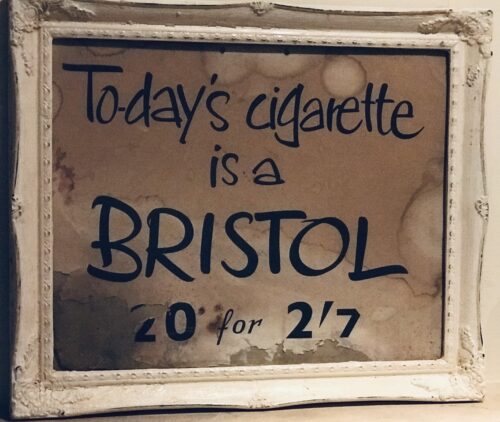
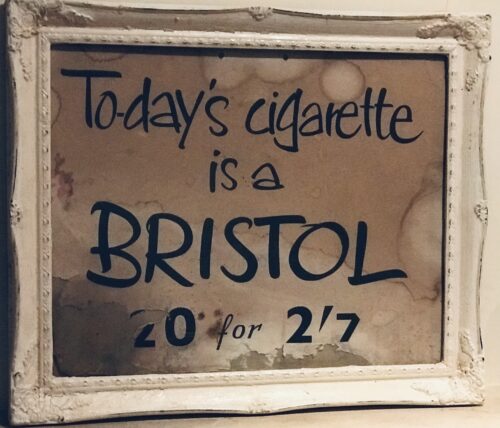

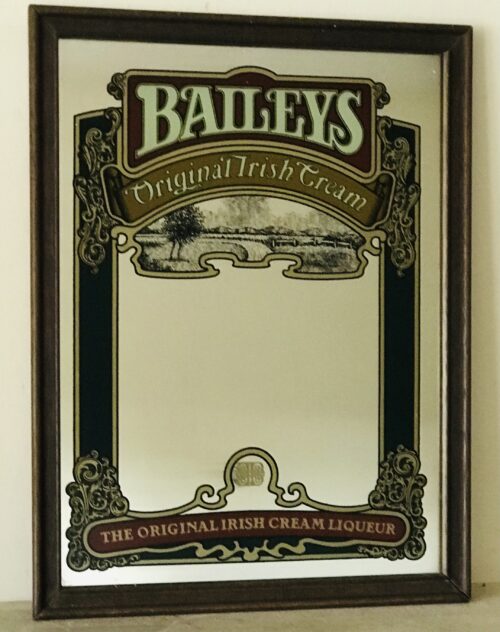












Fig.2 The chain and circumferentor were still the main tools of the trade in the 1750s. (Courtesy of the National Library of Ireland)

Fig.3 Carrickmacross, from Thomas Raven’s survey of Essex estate, County Monaghan 1634-5. Note the cluster of cabins, center right. (Courtesy of Marquis of Bath)

Fig.4 The manor of Tallow 1774 – part of Bernard Scale’s survey of County Waterford’s Devonshire estates. (Courtesy of the Trustees of the Chatsworth Settlement)

Fig.5 The town of Maynooth, County Kildare, from John Roque’s 1757 survey. (Courtesy of Patrick’s College, Maynooth)

Fig.6 Graigsallagh, from a volume of maps of the ‘Manor of Maynooth'(1821) by Sherrard, Brassington and Green. (Courtesy of carton Desmesne)


A 20-pack of Sweet Afton cigarettes with a text warning in both Irish and English stating "Smoking kills". |
|
| Product type | Cigarette |
|---|---|

| First Dáil | |||||
|---|---|---|---|---|---|
|
|||||
| Overview | |||||
| Legislative body | Dáil Éireann | ||||
| Jurisdiction | Irish Republic | ||||
| Meeting place | Mansion House, Dublin | ||||
| Term | 21 January 1919 – 10 May 1921 | ||||
| Election | 1918 general election | ||||
| Government | Government of the 1st Dáil | ||||
| Members | 73 | ||||
| Ceann Comhairle | Cathal Brugha (1919) George Noble Plunkett(1919) Seán T. O'Kelly (1919–21) | ||||
| President of Dáil Éireann | Cathal Brugha (1919) | ||||
| President of the Irish Republic | Éamon de Valera (1919–21) | ||||
| Sessions | |||||
|
|||||

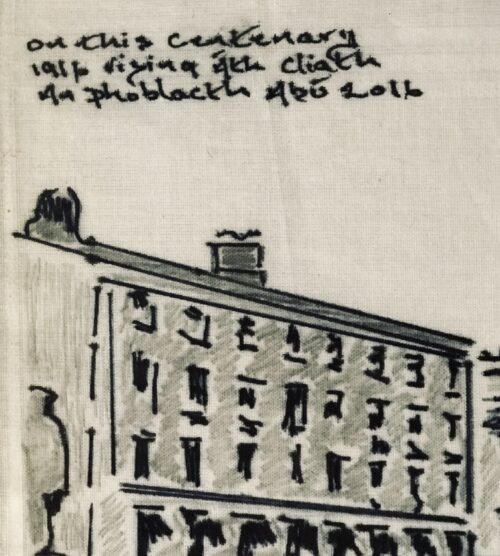

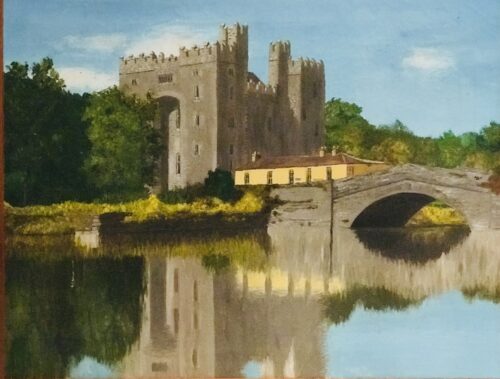
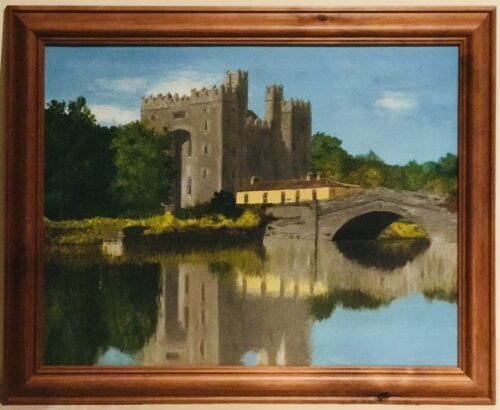


“The good news is, it will be staying in Ireland, ” says the managing director of Adam’s auction house, James O’Halloran. “That’s all we’ve been allowed to say for the moment, but we’re hoping that more information will be released fairly soon.” It’s understood that the State was outbid for the table and that the new owner is a private buyer.
Bidding on the table started at €70,000 but with one online bidder, three on the phone and one person in the room, it didn’t take long to sail past its lowest guide of €100,000, followed quickly by its top estimate of €200,000. “It got to €360,000 quite quickly,” O’Halloran says. “We thought it would do reasonably well, but because there was nothing to compare it to, we didn’t really know what to expect.”
The three-metre-long table was the property of Lord Inchiquin. Its rectangular top sits on a frieze of a dozen carved heads, with four carved heraldic lion corner supports and two figures of Hope and Charity, which would originally have been found on the stern of a galleon. It spent 300 years at Dromoland Castle before moving to Bunratty, where its elaborate series of carved masks became a key attraction.
When it was announced that the table – described by the Knight of Glin, Desmond FitzGerald, as “one of the most important and earliest pieces of Irish furniture” – was to be sold at Adam’s Country House Collections sale at Townley Hall, near Drogheda, Co Louth, there were calls for it to be kept in Ireland as it represents part of our cultural heritage. The only question now is, where will the table find its new home?

